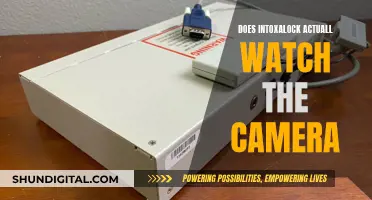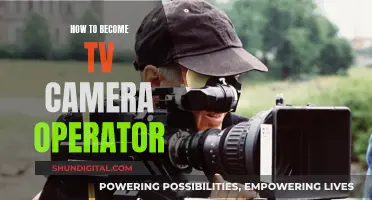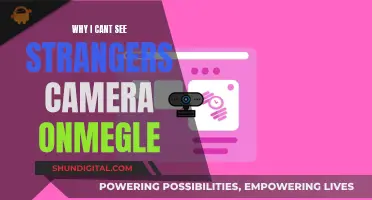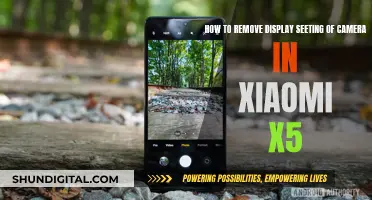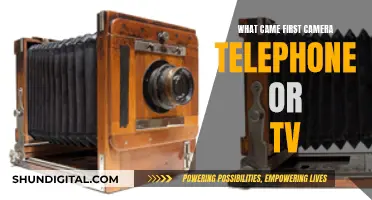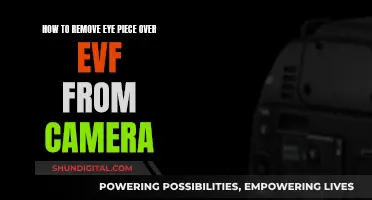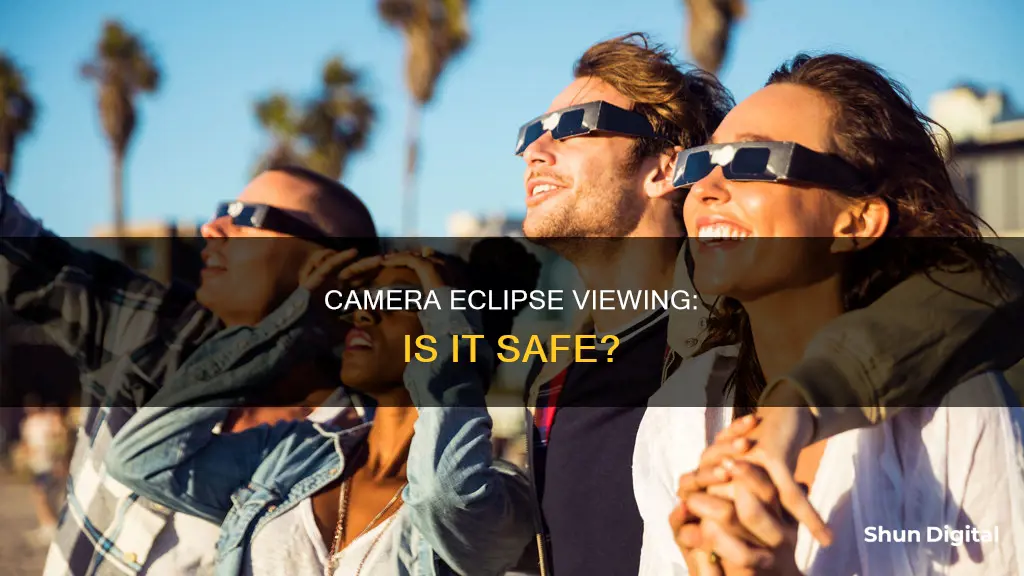
The solar eclipse is a rare phenomenon that many people will want to capture with their phones or cameras. However, it is important to be cautious when doing so, as the sun can cause permanent eye damage and may also damage your device. According to NASA, it is unsafe to look directly at the sun without specialised eye protection, and viewing it through a camera lens without a special-purpose solar filter can instantly cause severe eye injury. Experts recommend using proper ISO-certified filters or eclipse glasses in front of your device's lens when photographing the eclipse to avoid any damage.
| Characteristics | Values |
|---|---|
| Is it safe to watch the eclipse through a camera? | No, it is not safe to watch the eclipse through a camera without a special-purpose solar filter. |
| What type of filter is required? | An ISO-certified filter, ISO 12312-2. |
| What happens if you watch the eclipse through a camera without a filter? | It can damage the camera's sensor and cause severe eye injury. |
| What are some safe alternatives to watching the eclipse through a camera? | Using eclipse glasses, pinhole projectors, or watching livestreams of the eclipse. |
What You'll Learn

The dangers of looking at an eclipse without eye protection
Looking directly at the sun during an eclipse can cause serious and sometimes irreversible damage to your eyes. Even very short direct observations of the sun have the potential to cause harm. The sun's rays, focused on a single point, create a lot of energy. The lens in the human eye is about four times as powerful as a magnifying glass. This energy is enough to burn holes in the retina, or the light-sensitive cells at the back of the eye, resulting in a condition known as solar retinopathy.
The damage occurs in the fovea, a spot in the retina responsible for sharp, central vision. Patients with solar retinopathy may experience blurry vision or a central blind point in their eyes. While many patients recover from their symptoms, some are left with lasting vision problems. In rare cases, a person could become legally blind from staring at the sun.
The American Academy of Ophthalmology (AAO) recommends that people do not look directly at the sun with their naked eyes, even during a total solar eclipse. The only exception is during the brief period of totality when the sun is completely blocked by the moon. To view the eclipse safely, special "eclipse glasses" or handheld solar viewers with solar filters are necessary.
It is also important to note that you should never look at the sun through an unfiltered camera, telescope, or binoculars, even if you are wearing eclipse glasses. These devices focus the sun's rays even more than your eyes, leading to serious eye injury.
To protect your eyes from the dangers of looking at an eclipse without proper eye protection, always use certified eclipse glasses or handheld solar viewers with solar filters. Do not look directly at the sun with your naked eyes, except during the brief period of totality when it is safe to do so. By following these precautions, you can safely enjoy this rare and historic event.
Watching Sports with HD DV SQ11 Mini DV Camera
You may want to see also

The damage an eclipse can cause to a camera's sensor
An eclipse can cause severe damage to a camera's sensor. The sun's rays can damage a camera sensor if the camera is pointed directly at the sun, especially for longer exposures. The sensor can be fried, leaving a dark spot on it, and rendering the camera useless.
Photography experts advise using a solar filter to protect the camera's sensor. They are also useful for protecting your eyes when looking through the camera's viewfinder. The filter should be placed in front of the lens, and an ISO-certified filter is recommended.
It is important to note that the risk of damage is greater during an eclipse, as people tend to point their cameras at the sun for longer periods of time. Even a few seconds of exposure without a filter can be harmful. Additionally, the use of magnifying lenses, such as zoom lenses or binoculars, further increases the risk of damage to the sensor.
To summarise, it is crucial to use proper filters when photographing an eclipse to protect both your eyes and your camera's sensor from potential harm.
Zmodo Cameras on Fire Stick: Easy Viewing
You may want to see also

The importance of using protective filters
Protective filters are essential when viewing a solar eclipse through a camera, binoculars, or a telescope. Without them, you risk causing instant and severe damage to your eyes.
During a solar eclipse, it is unsafe to look directly at the sun without specialised eye protection. This includes viewing the sun through a camera lens, binoculars, or a telescope, which can cause severe eye injury. The concentrated solar rays will burn through the filter and harm your eyes. Therefore, it is crucial to use a special-purpose solar filter designed for the specific optical device you are using. These solar filters must be attached to the front of any camera lens, binoculars, or telescope.
Smartphones and digital cameras lack the protective filters necessary for safe solar photography. As a result, pointing them directly at the sun can damage the sensor. This risk is heightened when using magnifying lenses such as zoom lenses, telescopes, or binoculars, which condense light and increase the risk of eye damage. To mitigate this, it is essential to use protective filters in front of the camera lens or eyeglasses.
During a total solar eclipse, when the moon completely blocks the sun, it is safe to remove protective filters and view the sun's outer atmosphere, the corona. However, as soon as the sun begins to reappear, it is crucial to put protective filters back in place to avoid eye damage.
To summarise, protective filters are critical when viewing a solar eclipse through a camera or other optical device. They safeguard against severe eye injury and sensor damage by blocking harmful solar rays. By following these precautions, you can safely capture and view this rare celestial event.
Moto 360 Watch: Camera Feature or Missing Component?
You may want to see also

The safety of looking at an eclipse through a camera screen
Looking at an eclipse is an awe-inspiring experience, but it is important to take precautions to protect your eyes and equipment. While it may be tempting to use your camera screen to view an eclipse, there are some important safety considerations to keep in mind.
Firstly, it is crucial to understand that looking directly at the sun, even during an eclipse, can cause permanent damage to your eyes. This includes looking at the sun through a camera screen or viewfinder. The camera screen may not provide sufficient protection for your eyes, and the concentrated solar rays can still cause serious injury. Therefore, it is generally not recommended to look at an eclipse through your camera screen.
However, if you wish to use your camera to view the eclipse indirectly, there are some safe methods to do so. One way is to use a pinhole projector, which involves creating a small opening in a piece of cardboard or paper and projecting an image of the eclipse onto a surface. You can then safely view the projected image without looking directly at the sun. Another option is to use a colander, which will project crescent shapes onto the ground during the partial phases of the eclipse.
Additionally, it is important to consider the safety of your camera equipment when viewing an eclipse. Prolonged exposure to the sun can potentially damage the image sensor of your camera, especially if it is pointed directly at the sun. To protect your camera, it is recommended to use a special solar filter that complies with the ISO 12312-2 international standard. This filter should be secured over the front of your camera lens to reduce the amount of sunlight entering the sensor.
By following these safety guidelines, you can safely use your camera to view and capture the eclipse while protecting your eyes and equipment from potential harm. Remember to always prioritize eye safety and never look directly at the sun without proper protection.
Gizmo Watch: Camera-Equipped or Camera-Free for Kids?
You may want to see also

The safety precautions for photographing an eclipse
Protective Gear
- Always wear certified solar viewing glasses to protect your eyes during the partial phases of the eclipse.
- Use a solar filter to protect your camera equipment when viewing the partial phases of the eclipse.
- During the short period of totality, it is safe to remove your glasses and camera filter. However, replace them as soon as the diamond ring starts to appear again, signalling the end of totality.
- If using a magnifying lens, such as zoom lenses, telescopes, or binoculars, protective filters are particularly important to safeguard your eyes and equipment.
Camera Setup
- Use a tripod to stabilise your camera and avoid blurry images, especially in low lighting conditions.
- Use a delayed shutter release timer to avoid jiggling the camera when taking photos.
- If using a DSLR camera, switch off vibration reduction or image stabilisation as it is not required when using a tripod and will result in a poorer image.
- Use aperture priority mode and experiment beforehand to find the optimal aperture setting for your lens.
- Choose an appropriate ISO to avoid too long or too short of a shutter speed. Aim for a base exposure between 1/100s and 1/500s, depending on the focal length.
- Bracket your exposures to account for changes in lighting and to capture a range of images with different exposures.
- Dial in your settings ahead of time by testing them on the uneclipsed sun.
Additional Tips
- Clean your camera equipment before the eclipse to ensure any specks of dust do not appear in your images.
- Arrive at your chosen viewing location early to set up your equipment and check for any obstructions.
- Level your tripod and position it somewhere stable, ideally away from other people to avoid accidental bumps.
- Practise your photography techniques ahead of time, especially if using a telephoto lens or capturing wide-angle shots.
- Do not use a flash when photographing the eclipse, as it will not illuminate the subject and will be annoying to those around you.
- Bring extra batteries and memory cards to ensure you do not run out of power or space during the event.
- Remember to look at the eclipse with your own eyes and enjoy the experience!
Laptop Camera: Am I Being Watched?
You may want to see also
Frequently asked questions
No, it is not safe to watch the eclipse through a camera without a special-purpose solar filter.
Viewing the eclipse through a camera without a filter can damage the image sensor of your camera.
You should use an ISO-certified filter, ISO 12312-2.
You can tape the filter over your camera's lens. If your camera has multiple lenses, make sure they are all covered.
Yes, you can use your phone to view the eclipse, but only with the proper filter.


